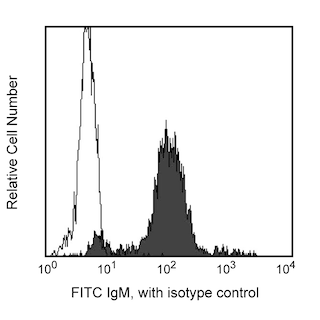-
Your selected country is
Middle East / Africa
- Change country/language
Old Browser
This page has been recently translated and is available in French now.
Looks like you're visiting us from {countryName}.
Would you like to stay on the current country site or be switched to your country?
.png)
.png)
Regulatory Status Legend
Any use of products other than the permitted use without the express written authorization of Becton, Dickinson and Company is strictly prohibited.
Preparation And Storage
Recommended Assay Procedures
This antibody conjugate has been tested by immunofluorescent staining (≤ 1 µg/million cells) with flow cytometric analysis on rat splenocytes and human lysed whole blood and as a second-step reagent on mouse splenocytes to assure specificity and reactivity. This antibody stains rat peripheral B cells, and it has little reactivity with rat non-B splenocytes, mouse splenocytes, or human peripheral blood leukocytes. As a second step, it is reactive with rat IgG and IgM monoclonal antibodies; a weaker signal is detected when the primary antibody has a rat IgG2b isotype. It has weak cross-reactivity detectable by flow cytometry with some, but not all, hamster immunoglobulins. Consequently, it may be useful as a primary reagent in immunofluorescent staining of rat antibody-producing cells or as a secondary reagent for staining of mouse or human leukocytes after reaction with rat Ig primary antibodies. However, we have observed that the reactivity of polyclonal second-step antibodies to mouse or rat IgM may be reduced after adsorption against Ig of rat or mouse, respectively. Because this anti-rat Ig antibody was adsorbed with mouse Ig, it may be weakly reactive with some rat IgM primary antibodies. In those cases, we recommend FITC-conjugated anti-rat IgM mAb G53-238 (Cat. no. 553887) or FITC-conjugated anti-rat Ig κ light chain mAb MRK-1 (Cat. no. 553872).
Product Notices
- Since applications vary, each investigator should titrate the reagent to obtain optimal results.
- Please refer to www.bdbiosciences.com/us/s/resources for technical protocols.
- Caution: Sodium azide yields highly toxic hydrazoic acid under acidic conditions. Dilute azide compounds in running water before discarding to avoid accumulation of potentially explosive deposits in plumbing.
- Source of all serum proteins is from USDA inspected abattoirs located in the United States.

Please refer to Support Documents for Quality Certificates
Global - Refer to manufacturer's instructions for use and related User Manuals and Technical data sheets before using this products as described
Comparisons, where applicable, are made against older BD Technology, manual methods or are general performance claims. Comparisons are not made against non-BD technologies, unless otherwise noted.
For Research Use Only. Not for use in diagnostic or therapeutic procedures.
Report a Site Issue
This form is intended to help us improve our website experience. For other support, please visit our Contact Us page.
